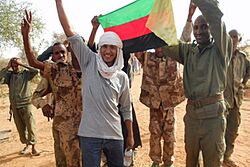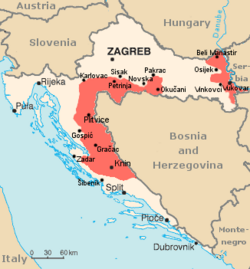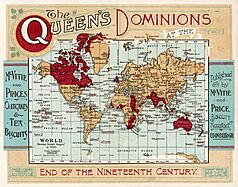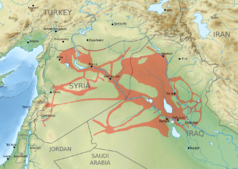Quasi-state facts for kids
A quasi-state (also called a state-like entity or proto-state) is a political group or area that acts like a country but isn't fully independent. It doesn't have all the parts of a true sovereign state, which is a country that governs itself completely.
The exact meaning of "quasi-state" can change depending on how it's used. In the past, it described British colonies that could rule themselves in some ways (called home rule) but were still part of the British Empire. The "metropole" was the main country, Great Britain, that still had control. The different Republics of the Soviet Union were also seen as quasi-states. They were like separate areas with their own cultures, but they were still part of the larger Soviet Union.
Today, in the 21st century, "quasi-state" often refers to militant groups that want to break away from a country. These groups claim to control a specific area and do have some power there. However, they usually don't have a strong, organized government that works well. Examples of these modern quasi-states include Republika Srpska and Herzeg-Bosnia during the Bosnian War. The Islamic State is another well-known example of a modern quasi-state or proto-state.
Contents
How Quasi-States Formed Over Time

The idea of a "proto-state" goes way back to Ancient Greece. It describes how large, strong nations often started as very small, loose groups. For example, in the Greek Dark Ages, societies began as "stateless" (no government). Then they became "semistates" led by powerful individuals, but these couldn't last. Finally, some turned into "protostates" with leaders who could keep power for generations. These eventually grew into bigger, more organized states by 700 BC.
Most ancient proto-states came from tribal societies. They were often short-lived groups of communities that joined together under a single warlord or chief. These weren't considered sovereign states because their governments weren't permanent. Their power was often over moving groups of people, not a fixed territory. This type of loose group was common in places like the Central Asian steppes throughout ancient history.
In Western Europe during the Middle Ages, many proto-states appeared. This happened because the Western Roman Empire fell, and power became less centralized. This led to feudalism, where many smaller nobles ruled their own lands (called fiefs). Even though they were supposed to be loyal to a king, they acted like tiny "states within states." This was very clear in large, decentralized areas like the Holy Roman Empire, which had many independent proto-states.
After the Age of Discovery, European colonialism led to new colonial proto-states in Asia, Africa, and the Americas. Some colonies were given special status, like protectorates or self-governing colonies. These areas were controlled by the main European country but had some power to rule themselves. They acted like states but weren't fully independent. These colonial proto-states later became the basis for many modern nations, especially in Asia and Africa.
In the 20th century, some proto-states were not just separate areas but also theoretically self-governing republics. They joined together in political unions, like the socialist federal systems in Yugoslavia, Czechoslovakia, and the Soviet Union.
Another type of proto-state has become common since World War II. These are formed when a rebel or militant group takes control of an area without permission from the main government. They then start acting like a real government. Even if other countries don't recognize them, these rebel proto-states might trade with others, offer services to people, and even do some limited diplomacy. They are often formed by ethnic or religious groups who want to live under their own rules. Since the 1980s, a special type called "Jihadi proto-state" has emerged. These groups, like the Islamic State, are very flexible in how they define a state. An emirate, for example, can be a large area or just a neighborhood ruled by an emir. Claiming to be a state helps these groups feel more legitimate and united against their enemies.
The idea of a rebel group taking over land to form a proto-state became well-known during the Chinese Civil War with Mao Zedong. This set an example for many similar attempts later on. Proto-states formed during conflicts are often in constant war. Their wealth and population might be limited because of this. The Islamic State of Iraq and the Levant is a major example from the 21st century. It had its own government offices and collected taxes.
What Makes a Proto-State Different?
It can be tricky to define a proto-state because the words "state," "country," and "nation" are often used to mean the same thing. However, "proto-state" is preferred over "proto-nation" in academic discussions. This is because "nation" can also mean a social or cultural group that might form its own state.
A proto-state doesn't meet the four main requirements for being a full state, as set out in the 1933 Montevideo Convention. These rules say a state needs:
- A permanent population (people living there all the time).
- A defined territory (clear borders).
- A government with its own institutions (rules and organizations).
- The ability to interact with other states (like making treaties).
A proto-state is not the same as a state with limited recognition, like Rhodesia or Taiwan. These limited-recognition states usually have all the features of a fully working country. However, proto-states are often not recognized by other countries. This is because recognizing a proto-state would mean going against the power of another country. If a proto-state gets full diplomatic recognition and exchanges ambassadors, it becomes a sovereign state and is no longer called a proto-state.

Throughout history, areas within larger, recognized countries have been seen as proto-states. This is especially true for regions with a unique history or culture that makes them different from the rest of the country. When these regions have "home rule" (some self-governance), they create their own local government structure, which can be called a proto-state. Also, when a rebellion takes control of an area and starts to set up some kind of government, it becomes a proto-state. These wartime proto-states, sometimes called "insurgent states," can change a country's structure or create their own independent political areas. While not new, the modern idea of militant groups forming proto-states became popular with Mao Zedong during the Chinese Civil War. Many national liberation movements around the world adopted his ideas.
Secessionist proto-states (groups trying to break away) are most likely to form in countries that don't have clear borders, a well-defined group of citizens, or a single government that controls all military force. They can be created by putsches (sudden takeovers), insurrections (rebellions), separatist political campaigns, foreign interference, sectarian violence (violence between different groups), civil war, or even the peaceful breakup of a state.
Proto-states can be important in a region. Their existence affects the choices available to other countries, either as possible allies or as obstacles to their political or economic plans.
See also
- Aspirant state
- Deep state
- Failed state
- List of sovereign states
- Nation-building
- Rump state
- Sovereign state
- State-building
Images for kids
-
A map of the British Empire under Queen Victoria in the late 1800s. "Dominions" meant all lands belonging to the British Crown.
-
The largest area controlled by the Islamic State (often called a proto-state) in Iraq and Syria, on May 21, 2015.






